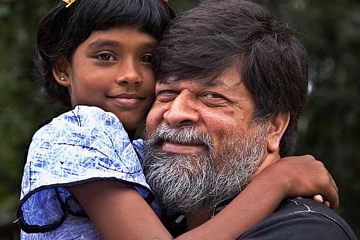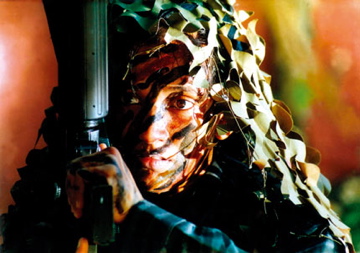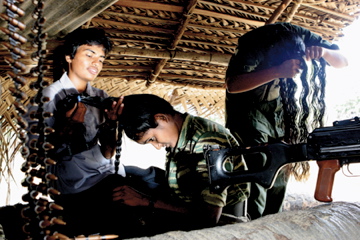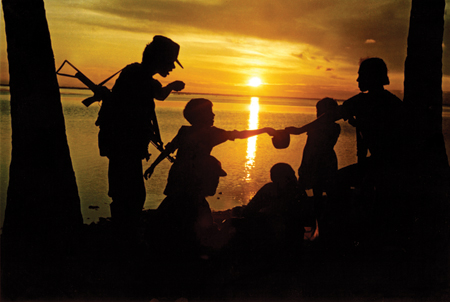Any news? I had asked the intermediary, after the fall of Kilinochchi. ?I fear the worst? was the short reply.
?We had never met. It was always through the intermediary that she approached me. Image files encrypted layers deep in ?less likely to be searched? laptops were passed on. Endless conversations about her, without her ever being present. Photographs, letters, and at a later stage films, are all that remain with me.
?
?
?Theepa* was a commander in the LTTE. I knew her as a photographer. In a letter to me, translated by the intermediary, she had written. ?Even after an artist?s death art lives. After death it will be so. I have that small belief.? She took photographs of conflict, of death, but there were also those tender moments, of women doing each other?s hair in the bunker. Footsteps in the sand, idyllic sunsets. This was a part of Kilinochchi daily life I had never seen.
There are those who mourn for Prabhakaran. Those who gloat at his death. Leaders are vilified, deified, mummified, bought, sold, traded. But they are the ones remembered. The foot soldiers, who have less to gain and far more to lose, are oft forgotten. She lived an extra ordinary life in the hope her people could live ordinary ones.
Theepa* had wanted to study at Pathshala, the photography school that we ran. The LTTE had a well-developed media campaign. Even in the early days, Prabhakaran?s hunger strike in Chennai in 1986, had been for the immediate return of ? not his rocket launchers, SAM missiles and AK-47s ? but his lifeline to the world, his wireless sets.
The ?Big Boss? knew the value of having a good photographer. So when her intermediary sent me this message ?She told me last night that the ‘Big Boss’ here is very happy with the way things are unfolding for her concerning the magazine articles and Chobi Mela etc. etc.? He has just bought her a Canon D1 Mark II as a gift and is willing to set her ‘free’ in January 2008,? I was elated.?
She had submitted work for Chobi Mela IV. We had hung the work at Shilpakala Academy, the academy of fine and performing arts. Later it showed in the Brussels Biennial. I had sent her photo magazines, the Drik brochure and the Chobi Mela IV catalogue. Big boss had requested an extra one for himself. Her photography was changing, she was having a go at ?art photography? dabbling in film. Some of the films she sent were very well made. It was in the genre of the early German and Russian propaganda films. Her?s were in colour with well mixed music, smooth tracking and fast cuts. I pondered on the propaganda, but delighted in her new skills. And then the communication stopped. Things had changed by January 2008.?
In her writing I appeared as an elder brother, a teacher. anna and aasiriyar. She was my little sister thangai. While she appreciated me helping her with her photography, it was my refusal to pre-judge her that formed the basis of our bonding. As I wrote about her to Rahnuma, my partner, I realised I was weeping. Tears for a little sister I had never met. Fondness for a student I had never encountered. Rahnuma too shed tears at the other end of the chat line. She had only known her thangai through me. This unseen, unknown, untouched little sister who had entered our lives. I had nominated her for awards where she had been turned down because she was a terrorist. I remember how in 1971, when that word had not yet become fashionable, the Pakistani media called us ?miscreants?.
 Shanika and Shahidul ? Chulie de Silva
Shanika and Shahidul ? Chulie de Silva
She longed to see me, but warned me against going to Kilinochchi. It was too dangerous. I remembered another Sri Lankan girl, another thangai, whom I?d met after the tsunami. Shanika had lost her mother and her three sisters to the sea, and warned me to stay away from the water. Theepa remembered a mob killing six of her family in 1983. Kilinochchi was the sea, she wanted to shield me from. I the anna, remember my two little thangais, one Sinhalese, one Tamil, who both wanted to shelter me from harm.
She was a fighter who had wanted to be an artist. A worker who wanted to be a poet. She was prepared to die, but longed to live.
She, like so many others who have been oppressed, will forever yearn for freedom. Until another?s prosperity gives one joy; until another?s sorrow gives one pain; until the betterment of another becomes one?s concern; until one is liberated by another?s freedom; victory over another, will be a defeat for oneself.
I talk of her in the past, but against my better judgement, I believe she may be alive. Perhaps in a rehabilitation camp with other fighters. In her letter she had said, ?I hope that if our liberation war lets me live then I would love to meet you.?
Wherever she may be, I know we will meet. Together we?ll explore photography.
————————-
*Not her real name
?
?
?




I was overwhelmed to read this article. It made me cry.
This motto should be well publicised, Until another?s prosperity gives one joy; until another?s sorrow gives one pain; until the betterment of another becomes one?s concern; until one is liberated by another?s freedom; victory over another, will be a defeat for oneself.
Even if people follow a fraction of it then the world will be a better place.
Shahidul you are an amazing writer…i was just wondering how meticulously you explore your feeling…
Your every little words seemed crying for the foot soldiers who are the expendible community…
I happened to see the documentary on LTTE shown this year at Chobi Mela which made me sensitive about the fact again and then this unfortunate fall for whatever the reasons are…
Thanks again.
Shahidul,
I really appreciated this entry given a lot of the stuff being printed in media after the military victory over the LTTE. The story is far from finished and being able to step back and look at the bigger picture is valuable during a juncture like this in history.
Thanks
Sir,
Please keep writing. don’t let us sleep. don’t let media and propaganda trap us.
Your write up touched me!!
Dear Shahidul:
Wonderful write up. Reminds me of a fellow student at Caltech, Chelvakumar when we were both doing Ph.Ds. We became good friends. Chelva became good friends with me, though I have lost touch with him recently. This was 1983, and he was passionate about the Tamil cause, and I remember expressing solidarity with the basic premise that as minorities, they should not be discriminated against. As Bangladeshis in Pakistan era, we should be acutely aware of how it feels to be sidelined in your own country.
Later, the Tamil movement took a violent turn, and Prabhakaran seemed to have become the mini-dictator. I hope in victory, Srilankan leaders recognize the human side of the struggle of their adversaries and look for ways to deal humanely with the wounds created by this war.
I was overwhelmed to read this article. It made me cry.
I am greatly disturbed by this article. While you begin the article by making a distinction between Prabakaran and Theeba, when you say, ‘She lived an extra ordinary life in the hope her people could live ordinary ones.’ The people in this country, particularly the tamils and Muslims of the north adn east, and maybe, teh Sinhalese of the border areas too, had been living extraordinary lives for a long time; much of the extra ordinariness of their lives come from harassment by the state. But teh LTTE has been one of the greatest perpetrators of atrocities in this country, against, Tamil people. I repeat Tamil people. I know that you are not saying much of the LTTE. But in talking about the LTTE in this a political nostalgic way, even via a photographer, who obviously, dreamt for something, I think you elide something important to us in Sri Lanka. The blood bath that the LTTE led the Tamil people into, particularly in its last days. Her dream to live has been shattered for the most part by that criminal Prabakharan. I generally like your writing. But for some reason I could not find this moving. Your story hides too much from us the public view. It’s too sentimental, and I use the word sentimental, not to trash you, but in then sense that your piece is not political. In every story like Theeba’s we have a story of conscription, forced for the most part. Of poverty; of 200,000 people dragged from teh east to the west of the northern peninsula to be used as cannon fodder so that the life of one mad man could be saved. Behind every dream of Tamil eelam there is a night mare of enormous suffering that the people suffered at the hands of these dreamers. I do not know of Theeba herself. Her ‘real’ story. But the story of the cadres of the LTTE is something no photographs will be able to capture for a very very long time. Your story does not even point to that impossibility. That’s why I write this. This story does not lead to even a moment’s reflection on the terrible events we have experienced in the last few months.
“… Until another?s prosperity gives one joy; until another?s sorrow gives one pain; until the betterment of another becomes one?s concern; until one is liberated by another?s freedom; victory over another, will be a defeat for oneself.”
— wish the world learns this soon!
the world has shed enough blood over ethnic-racial fights. Enough and more is already paid, to keep the dominant more privilaged. If whole of Europe, after fighting for centuries together , could come together shedding away minor difference to stand as one ‘society’, why not asia or africa? Hope we learn to live as one ‘human community’ as early as possible.
And i take exception to Ms. Sumathy’s comment. The story is one sided- the human sided! and it is this side we need to take if we believe in securing a good future for all of us and those for whom we leave the world behind.
Are you a nymph Shahid…..
Dont Hug young girls like this.
Show your full picture
Rajesh Naik, I did not say that the story was one sided. It’s a beautiful story. It made people cry. That was my problem. Too beautiful for me in Sri Lanka to appreciate. The story of eelam is a sordid one. Dreaming of eelam has been a nightmare. For me the story by Shahidul Alam is a story that comes from being far away and disconnected from the many realities of the war for us. When I say disconnected I do not want to say that he is an outsider. The story hides too much of the pain. In that sense it might be a bit voyeurstic. That’s why I said the story of Theeba and those of many like her are necessarily much more complex. Well, I am not demanding that all that complexity has to be put out there. But that complexity is not even pointed to. This is why I say, is it dreaming of eelam, or the nightmare of eelam? The question that I ask, and one I must say I ask reluctantly (for it again brings up the question of outsider/insider) is for whom is Shahidul Alam writing. I hate to draw outsider/insider distinctions, because such distinctions do not really exist for me. So, I am framing it differently. For whom is he writing? And he is not writing for me. Rajesh Naik, Please read what I wrote carefully. Do not jump to hasty conclusions. As it is it has been difficult for me to write this. I am asking for a politics of engagement from Shahidul Alam. And by that I am not asking him to side with this group or another. No, I am asking him to engage more deeply with teh story of eelam and its dreams.
Sumathy
Sumathy
Freedom is the right of every individual and one can only admire the spirit of a man or a woman willing to sacrifice one’s life for the cause.
However, with every one walking one’s own walk, there can only be true mayhem.
Just as a garden is beautiful, wild or laid out, when there is collection of colors and variety; should we not aim for that.
I wish all Sri Lankans a happy and peaceful future with mutual respect, understanding and love amongst all
Iqbal, I take it that you are responding to me. If you are,
that is precisely what I cannot admire in the LTTE. If we take the ‘tragedy’ or pathos of Theeba’s life/story out, what is left of the story of the LTTE is ruthlessness and a singular drive to eliminate all opposition. What exactly is the cause of the LTTE are you talking about? We can go on in an enless circle ruminating and arguing this point. If you are really really interested, I recommend among other things, The Broken Palmyrah, by Hoole, Sritharan, Rajani Thiranagama and Somasundaram. If you need more details, one of its authors, Rajani Thiranagama was killed in 1989 for writing this book. It should be widley available. Her co authors, Rajan Hoole and Sritharan continued to struggle for human rights and continued with teh work they initiated with Rajani, as University Teachers for Human Rights (J). there is a website. Read their stuff. There is a film on Rajani, ‘No More Tears, Sister: an anatomy of hope and Betrayal. There is a website for this film. It has been shown widely in south asia including a screening at the South Asia, himal’s documentary festival. A couple of years ago, a film that I was involved in was screened there, In Search of a Road.
My own work and position on the issue can be got at from
Sivamohan Sumathy, Militants, Militarism and the crisis of (Tamil) nationalism, Thin Veils (two plays), and like myth and mother, a political autobiography in poetry and prose.
You may also want to read Kethesh Loganathan’s ‘Lost Opportunities’. Kethesh was killed by the LTTE in 2006.
Read about Neelan Thiruchelvam (killed by the LTTE in 1999). Neelan brought about the best proposal for devolution for power. The LTTE feared that peace might finally come to Sri Lanka through a political solution and got rid of him. Just a year ago, another activist, Maheshwary Velayuthan was killed. In 1990 aroudn 75, 000-85, 000 Muslims were forcibly evicted from the northern peninsula. In the east, the LTTE (along with other groups), fanned anti-Muslim feelings among Tamils. please read Hasbullah on this re; northern muslims. you can also read my own written together with 13 other displaced Muslim and tamil women, Salt, Sand, Water: movement and citizenship
in the narratives of displaced women.
There is so much more to read. I just suggested some of my own work here, because that’s what I can rememeber off the top of my head. But I am putting so much down, because when people speak of the cause, I want to ask, what cause. Do you know what the cause of the LTTE was? Do you know the cause of teh Tamil people? who are the Tamil people?
I am all for diversity. Political diversity as well. But that comes with tolerance. Not with killing off diversity the way the LTTE did.
To Rajesh Naik,
I am not sure whether europe is coming together shedding off some minor differences: It’s the Muslims that are outside of these ‘minor differences.’ I was amused to see how all of the western media are talking about Obama’s visit to teh Middle east/west asia as visiting the Muslim world. There are Muslims in Europe and America. And then when the west tells us there is a Muslim world out there, we also start talking believing that.The formation of Europe is redrawing the boundaries against awful oriental and despotic asia, backward tribal arabs, wily Chinese and the likes, imperialistic indians (well!!), adn stupid tamil diaspora (well?) and corrupt african dicators. teh headscarf issue in France and other countries is just a superficial instance of this.
But to get back to my point about Dreaming of Eelam, I would not mind a happy family of humanity. who likes war?
But you are missing my point totally! that is exactly what I want too. A tolerant and just society. And we need to talk about it and act upon it if we want to move onto a better world.
Thanks to all of you — Shahidul, Theepa and Sumathy — for the stories and analysis. The story was indeed touching — but the comments by my friend Sumathy capture — better than I would have been able to — why Shahidul’s story also left me feeling uncomfortable. As Sumathy says, it doesn’t even hint at the complexity of the forces that led to Theepa’s death. And the occasional references to the “big boss” give you no sense of what an insane bastard Prabhakaran was and how he responsible he was for the tens of thousands of Tamils — including Theepa — dead or locked up in internment camps. He was the best thing all the neo-fascist Sinhala supremacists — like the current Army Commander and the President’s brother the defence Secretary — could have ever hoped for. The damage he’s done, with their help, to Tamils will last decades. Theepa “dreams” had little chance of being realised so long as they were attached to Prabhakaran’s insanity. Thanks, Sumathy, for your careful and non-dogmatic critique.